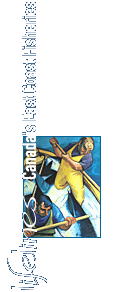|
The Discovery of Newfoundland in 1497
There was an abundance of cod in the waters around
Newfoundland.
 he discovery of the island
by two navigators, John Cabot, a Venetian at the service of the king
of England (1497), and Gaspar Corte Real (1500), who arrived from
Portugal, opened up a new area that was immensely rich in fish and
marine mammals. he discovery of the island
by two navigators, John Cabot, a Venetian at the service of the king
of England (1497), and Gaspar Corte Real (1500), who arrived from
Portugal, opened up a new area that was immensely rich in fish and
marine mammals.
The news spread through every port. Cod could be caught simply by
dipping a basket in the sea. One can only imagine how excited the
fishermen must have been. Several cartographers identified Newfoundland
and part of the coast of Labrador as Ilha de Bacalhao and
Tierra del Bacalaos (island and land of cod).
|
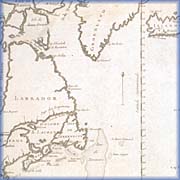
|

Truncated map of the region where cod was fished... (detail),
18th century
This map shows the two sides of the North Atlantic but is missing a large
part of the ocean between the Azores and the Grand Bank of Newfoundland.
From Traité général des pesches,
by Duhamel du Monceau, 1772
(National Library of Canada)
|
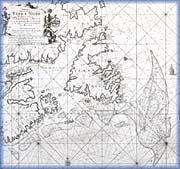
|

Map of Newfoundland and eastern New France highlighting
the fishing banks, ca. 1687
Engraved on copper by Johanne van Keulen (1654-1715), Amsterdam
(The James W. MacNutt Collection of Historic Maps, Prince Edward Island Museum
Number 94.84.4)
|
|
This map designed for a wide public highlights the shallow fishing banks along
the continental shelf under the Atlantic Ocean, as well as the numerous harbours
and coves from where fishermen set out to sea. The place names are in French and
Portuguese, but the map's title is in Dutch.
|
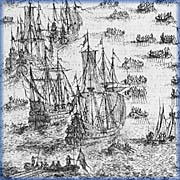
|

The Grand Bank (detail), 17th century
This illustration shows the heavy traffic in the area in the seventeenth century.
Engraving from Description de l'Univers by Manesson Mallet, 1683
Photo: Harry Foster, Canadian Museum of Civilization
(Collection of Nelson Cazeils,
Biarritz, France)
|
|
The First Fishing Expeditions to Newfoundland, ca. 1510
The Bretons were apparently the first to fish in
Newfoundland waters.
 he Bretons arrived on the
Bonne-Adventure, from the port of Bréhat (1508), and
the Jacquette, from Dahouët (1510). The Basques
appeared on the scene in 1512, followed by the Normans in 1524. he Bretons arrived on the
Bonne-Adventure, from the port of Bréhat (1508), and
the Jacquette, from Dahouët (1510). The Basques
appeared on the scene in 1512, followed by the Normans in 1524.
In 1527, John Rut, an English captain, found 12 French fishing vessels
in the harbour at St. John's, Newfoundland. According to an English
poem, at the time France already had over 100 ships in its fishing
fleet:
-
- Nowe frenchmen and other have founden the trade
- That yerely of fyshé there they lade
- Above a C [hundred] sayle.
Around 1550, about 500 ships left French ports. The English had a minor
presence in the fishery at the time.
|
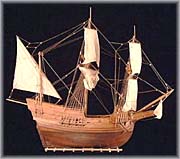
|

Merchant ship, 16th century
Model: Fred Werthman
Photo: Harry Foster
(Canadian Museum of Civilization)
|
|
A three-masted vessel of 100 to 120 tons that would have been used around
1540 as a merchant ship, as well as for fishing expeditions and voyages of
exploration. This reproduction is based on research done by the Marine
Archaeology Section at Parks Canada.
( QuickTime VR )
To view this QuickTime video, you need Apple's QuickTime player. You can
download it (it's free!) from
http://www.apple.com/quicktime.
|
|
